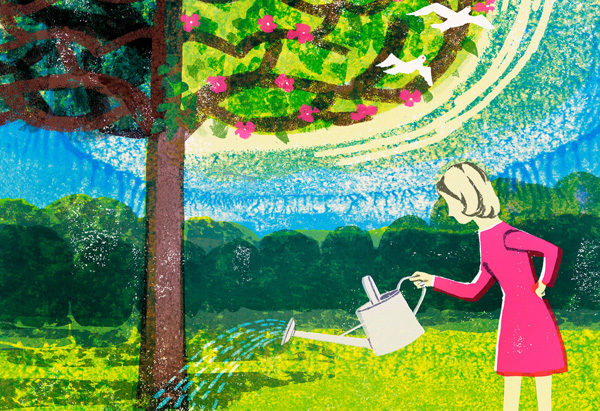Creativity Boost: How to Tap into Right-Brain Thinking
We've all heard that we need to tap into our creative right brains. But how? Martha Beck offers a few fruitful ways to branch out.

Illustration: Tatsuro Kiuchi
This morning I sat down to write about how we can all learn to better use the right hemispheres of our brains. For 30 minutes, I tapped restlessly at a laptop. Nothing much happened, idea-wise. Flat beer.
Finally I resorted to a strategy I call the Kitchen Sink. I read bits of eight books: four accounts of brain research, one novel about India, one study of bat behavior, one biography of Theodore Roosevelt, and one memoir of motherhood. Next I drove to my favorite Rollerblading location, listening en route to a stand-up comic, a mystery novel, and an Eckhart Tolle lecture. I yanked on my Rollerblades and skated around, squinting slack-jawed into the middle distance. After a while, a tiny lightbulb went on. "Well," I thought, "I could write about this."
Duh.
The Kitchen Sink, you see, is one way to activate your brain's creative right hemisphere. Every writer I've ever met uses some version of it, as do Web designers, cartoonists, TV producers—all "content creators" who regularly face the terrifying thought, "Well, I've gotta come up with something."
If you're not a content creator, wait a while. The 21st century is to content creators what the Industrial Revolution was to factory workers: In a world where information is superabundant, unique and creative ideas are hot-ticket advantages both personally and professionally. More and more people are finding more and more ways to parent, make money, find friends, and generally live well by relying on creativity. I've seen this shift among my life-coaching clients. For instance: Michaela develops financial-planning strategies for stay-at-home moms. Mary runs a long-distance mother's support group via Skype. Alyssa's innovative T-shirt designs keep selling, recession or no recession. The demand for creative thinking is both a challenge and an opportunity. It requires us to use more than the logical left-brain skills we learned in school. These days, we all need to get back into our right minds.
Finally I resorted to a strategy I call the Kitchen Sink. I read bits of eight books: four accounts of brain research, one novel about India, one study of bat behavior, one biography of Theodore Roosevelt, and one memoir of motherhood. Next I drove to my favorite Rollerblading location, listening en route to a stand-up comic, a mystery novel, and an Eckhart Tolle lecture. I yanked on my Rollerblades and skated around, squinting slack-jawed into the middle distance. After a while, a tiny lightbulb went on. "Well," I thought, "I could write about this."
Duh.
The Kitchen Sink, you see, is one way to activate your brain's creative right hemisphere. Every writer I've ever met uses some version of it, as do Web designers, cartoonists, TV producers—all "content creators" who regularly face the terrifying thought, "Well, I've gotta come up with something."
If you're not a content creator, wait a while. The 21st century is to content creators what the Industrial Revolution was to factory workers: In a world where information is superabundant, unique and creative ideas are hot-ticket advantages both personally and professionally. More and more people are finding more and more ways to parent, make money, find friends, and generally live well by relying on creativity. I've seen this shift among my life-coaching clients. For instance: Michaela develops financial-planning strategies for stay-at-home moms. Mary runs a long-distance mother's support group via Skype. Alyssa's innovative T-shirt designs keep selling, recession or no recession. The demand for creative thinking is both a challenge and an opportunity. It requires us to use more than the logical left-brain skills we learned in school. These days, we all need to get back into our right minds.



